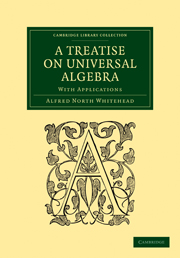Book contents
- Frontmatter
- PREFACE
- Contents
- BOOK I PRINCIPLES OF ALGEBRAIC SYMBOLISM
- BOOK II THE ALGEBRA OF SYMBOLIC LOGIC
- BOOK III POSITIONAL MANIFOLDS
- CHAPTER I FUNDAMENTAL PROPOSITIONS
- CHAPTER II STRAIGHT LINES AND PLANES
- CHAPTER III QUADRICS
- CHAPTER IV INTENSITY
- BOOK IV CALCULUS OF EXTENSION
- BOOK V EXTENSIVE MANIFOLDS OF THREE DIMENSIONS
- BOOK VI THEORY OF METRICS
- BOOK VII APPLICATION OF THE CALCULUS OF EXTENSION TO GEOMETRY
- Index
CHAPTER I - FUNDAMENTAL PROPOSITIONS
Published online by Cambridge University Press: 29 August 2010
- Frontmatter
- PREFACE
- Contents
- BOOK I PRINCIPLES OF ALGEBRAIC SYMBOLISM
- BOOK II THE ALGEBRA OF SYMBOLIC LOGIC
- BOOK III POSITIONAL MANIFOLDS
- CHAPTER I FUNDAMENTAL PROPOSITIONS
- CHAPTER II STRAIGHT LINES AND PLANES
- CHAPTER III QUADRICS
- CHAPTER IV INTENSITY
- BOOK IV CALCULUS OF EXTENSION
- BOOK V EXTENSIVE MANIFOLDS OF THREE DIMENSIONS
- BOOK VI THEORY OF METRICS
- BOOK VII APPLICATION OF THE CALCULUS OF EXTENSION TO GEOMETRY
- Index
Summary
Introductory. (1) In all algebras of the numerical genus (cf. § 22) any element of the algebraic manifold of the first order can be expressed in the form α1e1 + α2e2 + … + ανeν where e1, e2, … eν are v elements of this manifold and α1, α2, … αν are numbers, where number here means a quantity of ordinary algebra, real or imaginary. It will be convenient in future invariably to use ordinary Roman or italic letters to represent the symbols following the laws of the special algebra considered: thus also each group of such letters is a symbol following the laws of the special algebra. Such letters or such group of letters may be called extraordinaries to indicate that in their mutual relations they do not follow the laws of ordinary algebra. Greek letters will be strictly confined to representing numbers, and will in their mutual relations therefore follow all the laws of ordinary algebra.
(2) The properties of a positional manifold will be easily identified with the descriptive properties of Space of any number of dimensions, to the exclusion of all metrical properties. It will be convenient therefore, without effecting any formal identification, to use spatial language in investigating the properties of positional manifolds.
A positional manifold will be seen to be a quantitively defined manifold, and therefore also a complex serial manifold (cf. § 11).
- Type
- Chapter
- Information
- A Treatise on Universal AlgebraWith Applications, pp. 119 - 131Publisher: Cambridge University PressPrint publication year: 2009First published in: 1898



